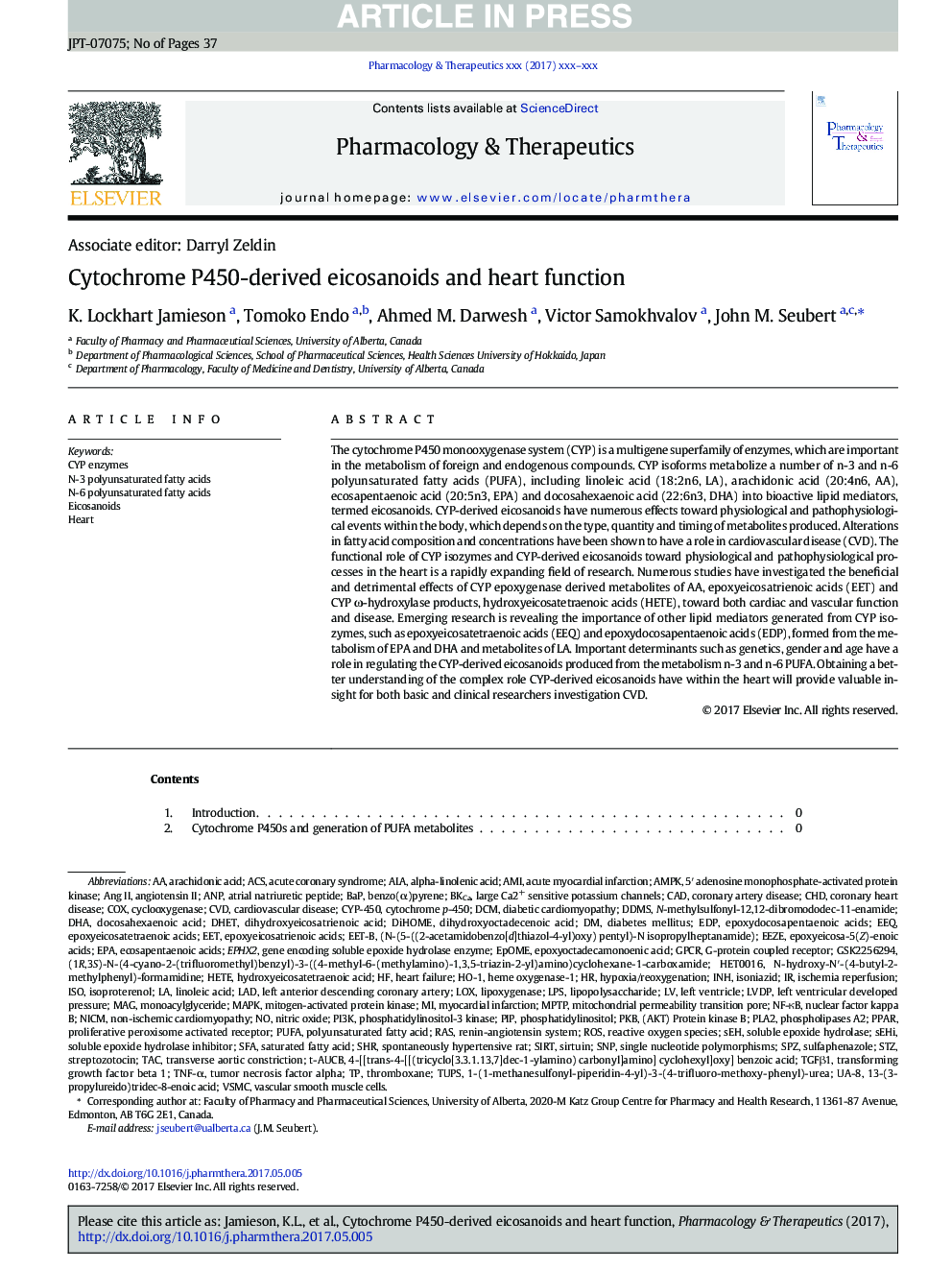| Article ID | Journal | Published Year | Pages | File Type |
|---|---|---|---|---|
| 8537020 | Pharmacology & Therapeutics | 2017 | 37 Pages |
Abstract
The cytochrome P450 monooxygenase system (CYP) is a multigene superfamily of enzymes, which are important in the metabolism of foreign and endogenous compounds. CYP isoforms metabolize a number of n-3 and n-6 polyunsaturated fatty acids (PUFA), including linoleic acid (18:2n6, LA), arachidonic acid (20:4n6, AA), ecosapentaenoic acid (20:5n3, EPA) and docosahexaenoic acid (22:6n3, DHA) into bioactive lipid mediators, termed eicosanoids. CYP-derived eicosanoids have numerous effects toward physiological and pathophysiological events within the body, which depends on the type, quantity and timing of metabolites produced. Alterations in fatty acid composition and concentrations have been shown to have a role in cardiovascular disease (CVD). The functional role of CYP isozymes and CYP-derived eicosanoids toward physiological and pathophysiological processes in the heart is a rapidly expanding field of research. Numerous studies have investigated the beneficial and detrimental effects of CYP epoxygenase derived metabolites of AA, epoxyeicosatrienoic acids (EET) and CYP Ï-hydroxylase products, hydroxyeicosatetraenoic acids (HETE), toward both cardiac and vascular function and disease. Emerging research is revealing the importance of other lipid mediators generated from CYP isozymes, such as epoxyeicosatetraenoic acids (EEQ) and epoxydocosapentaenoic acids (EDP), formed from the metabolism of EPA and DHA and metabolites of LA. Important determinants such as genetics, gender and age have a role in regulating the CYP-derived eicosanoids produced from the metabolism n-3 and n-6 PUFA. Obtaining a better understanding of the complex role CYP-derived eicosanoids have within the heart will provide valuable insight for both basic and clinical researchers investigation CVD.
Keywords
AMPKEPANF-κBPI3KLPSCOXINHDCMANPSPZACSHO-1BAPRASTACALAMAGSFAPPARSIRTsirtuinMPTPGPCRSTZEDPPKBHeme oxygenase-1VSMCCHDPLA2TGFβ1CYP-450LVDPNICMEPHX2Epoxydocosapentaenoic acidsEEQt-AUCBn-6 Polyunsaturated fatty acidsHET0016DDMSBenzo(α)pyreneAmIBKCaNon-Ischemic CardiomyopathyDHETG-protein coupled receptorMAPKn-3 Polyunsaturated fatty acidsROSsEHcyclooxygenaseCYP enzymesMyocardial infarctionAngiotensin IIstreptozotocinArachidonic acidalpha-linolenic acidepoxyeicosatrienoic acidsdocosahexaenoic aciddihydroxyeicosatrienoic aciddihydroxyoctadecenoic acidLinoleic acidhydroxyeicosatetraenoic acidsaturated fatty acidPolyunsaturated fatty acidPUFAmitochondrial permeability transition poreEpOMELOXISOisoniazidisoproterenolIschemia reperfusioneicosanoidsleft ventricleLeft ventricular developed pressurecoronary artery diseasecoronary heart diseasecardiovascular diseasetransforming growth factor beta 1thromboxanetransverse aortic constrictiontumor necrosis factor alphaSpontaneously Hypertensive RatEETAng IIDHADiabetes mellitusDiHOMECVDVascular smooth muscle cellsAcute coronary syndromesulfaphenazoleAcute myocardial infarctioncytochrome P-450renin-angiotensin systemShrCADTNF-αnuclear factor kappa Bphosphatidylinositolphosphatidylinositol-3 kinasephospholipases A2HeartLADlipoxygenaselipopolysaccharideSoluble epoxide hydrolase inhibitorheart failureNitric oxideHETESoluble epoxide hydrolasehypoxia/reoxygenationmitogen-activated protein kinase5′ adenosine monophosphate-activated protein kinaseSingle nucleotide polymorphismsatrial natriuretic peptidePiPSNPleft anterior descending coronary arterydiabetic cardiomyopathyReactive oxygen species
Related Topics
Health Sciences
Pharmacology, Toxicology and Pharmaceutical Science
Pharmacology
Authors
K. Lockhart Jamieson, Tomoko Endo, Ahmed M. Darwesh, Victor Samokhvalov, John M. Seubert,
